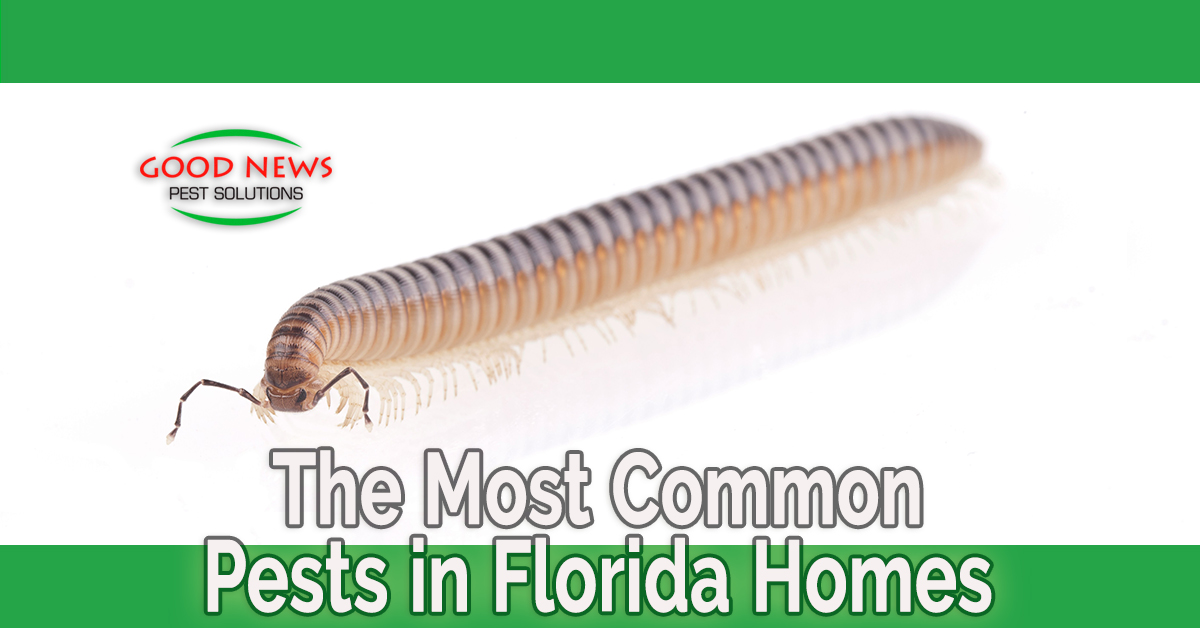
The Most Common Pests in Florida Homes – Part 4
Sometimes, what seems to be obvious isn’t really. For example, today we’re talking about pests you might find in your home, specifically, the arthropods known as centipedes and millipedes. What’s the difference between centipedes and millipedes? Clearly, one must be a lot longer because he’s got 10 times more legs, right?
Not exactly.
While the Latin points to this being an accurate representation – centi = 100, milli = 1000, and pedes = feet - maybe that was true once. But today for the creatures we’re looking at, the answer is often neither or sometimes both.
For starters, there are literally no millipedes with 1000 legs. Some centipedes don’t quite have 100 feet. And, surprisingly, there are a lot of millipedes with fewer than 100 feet – and not because they were in some tragic accident. On the other hand, some species of centipedes can have more than 350 legs, while a few millipede species boast as many as 750 legs.
And while both can wander into your home on the Gulf Coast of Florida, they are only distantly related.
Vice-Versus
Let’s start with what they have in common – or not. Both are myriapods, the Greek word for "countless feet." Their bodies have multiple segments. Centipedes have one pair of legs on every body segment that point away from their bodies. The smallest centipedes grow to less than a half-inch long but the biggest found are more than 12 inches long!
Millipedes, on the other hand, can be as tiny as a tenth of an inch. The largest get to around 10 inches. Millipedes have two pairs of legs per segment, they point to the ground, and their legs tend to be shorter than the centipede’s.
When you surprise a millipede he curls up into a ball and plays dead. Centipedes will scuttle away as fast as they can. Both are found on every part of the earth except Antarctica. Presumably, it’s too chilly for them there. Millipedes prefer warmer, wetter climes, while centipedes can adapt to just about any weather.
Both have poor or non-existent vision and are forced to rely on their other senses, often, like spiders, using vibrations to get information about their surroundings. We should also note that only 8000 species of centipedes exist while there are more than 80,000 species of millipedes on the planet.
Millipedes
Even though they may seem stranger than their arthropodal cousins, millipedes are generally more household friendly, although they’re more helpful outside of the house. Millipedes feed on decomposing plant matter and help your yard and garden because they break down organic material, providing natural fertilizer. You might think of them as natural recyclers or composters.
As noted, when startled or threatened, they curl up into a ball – you might see a bunch of them on your front porch or steps during certain parts of the year looking like fat pill bugs. To protect themselves, they will secrete a malodorous liquid that birds don’t like the taste of. Humans aren’t too fond of the smell either but it won’t hurt us, except for a few people with sensitive allergies that might react if the liquid gets on them.
Millipedes generally prefer to be outdoors but can sometimes end up inside, carried in while in a pot or seeking shelter from bad weather.
Centipedes
Centipedes tend to be flatter than millipedes and are more of a threat to other household pests. Their diet tends to be insects and the like – cockroaches, spiders, beetles, crickets, bedbugs, and silverfish. They’ll even snack on earthworms and other centipedes.
The only danger to humans from centipedes is from their bite. If the centipede can’t get away quickly enough and you catch one – which is highly unlikely – their bite feels a bit like a bee sting. For those folks with severe allergies, especially to insect venom, the reaction can be severe.
Centipedes are effective as natural pest control – but their presence often times signals a larger problem. If there’s plenty for them to eat, it can signal the presence of more insects you don’t want in your house.
The best way to get rid of centipedes in your home is to get rid of their food source. Thankfully, our Go Green Perimeter Plus solution can help with that. The first thing we do is inspect your home and yard, then suggest sealing any potential entry points. Then we use the most effective, green, safe- for-your-family treatment to eliminate the most common creepy crawlies from your home. For more details or to schedule your first appointment, please give us a call!
« Back to Blog
Proudly Serving
Sun City Center, Ruskin, Palmetto, Parrish, Ellenton, Bradenton, Anna Maria, Holmes Beach, Bradenton Beach, Longboat Key, Lakewood Ranch, University Park, Myakka City, Sarasota, Siesta Key, Osprey, Nokomis, Casey Key, Venice, Englewood, North Port, Port Charlotte, Punta Gorda, Arcadia
Things You Can Do
Pay Your Bill Online
Leave Us a Review
Request a Free* Termite Inspection
Stop Mosquito Bites
Get Rid of Rodents
Get a Termite Damage Warranty
Get Pest Control for Your Attic
Get Pest Control for Your Business Request Prayer
Corporate Address
1080 Enterprise Court, Ste A
North Venice, FL 34275
Call Now: (941) 412-9610
Text: (941) 412-9610
Fax: (941) 412-0080
